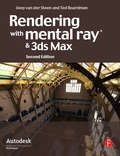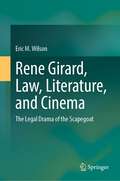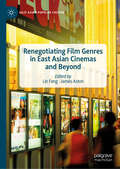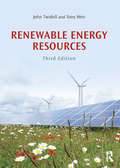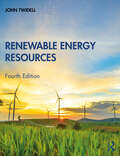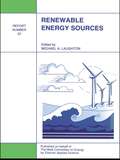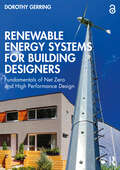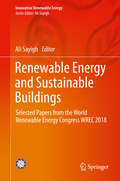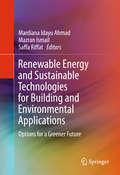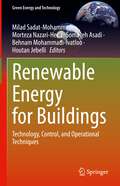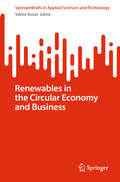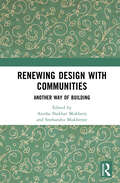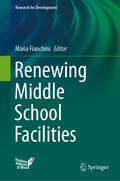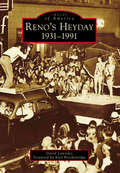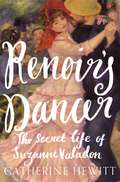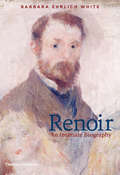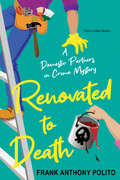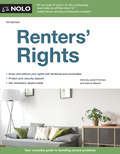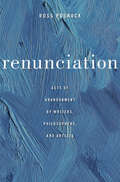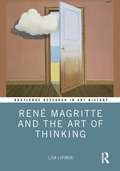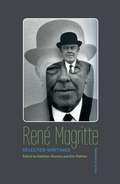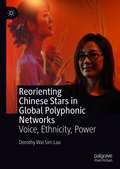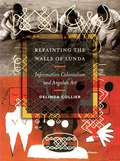- Table View
- List View
Rendering with mental ray and 3ds Max
by Ted Boardman Joep van der SteenCreate stunning renders of your 3ds Max models in mental ray with this concise guide. Learn all of the essential concepts such as indirect illumination, materials, render options, shaders, and lighting. Rendering with mental ray and 3ds Max, Second Edition is now revised to cover Autodesk Revit and special effects. The companion website includes all of the necessary project files from inside the book.
Rendez-vous with Art
by Martin Gayford Philippe De MontebelloThe fruits of a lifetime of experience by a cultural colossus, Philippe de Montebello, the longest-serving director of the Metropolitan Museum of Art in its history, distilled in conversations with an acclaimed critic Beginning with a fragment of yellow jasper--all that is left of the face of an Egyptian woman who lived 3,500 years ago--this book confronts the elusive questions: how, and why, do we look at art? Philippe de Montebello and Martin Gayford talked in art galleries or churches or their own homes, and this book is structured around their journeys. But whether they were in the Louvre or the Prado, the Mauritshuis of the Palazzo Pitti, they reveal the pleasures of truly looking. De Montebello shares the sense of excitement recorded by Goethe in his autobiography--"akin to the emotion experienced on entering a House of God"--but also reflects on why these secular temples might nevertheless be the "worst possible places to look at art." But in the end both men convey, with subtlety and brilliance, the delights and significance of their subject matter and some of the intense creations of human beings throughout our long history.
Rene Girard, Law, Literature, and Cinema: The Legal Drama of the Scapegoat
by Eric M. WilsonThis book is the first monograph to critically evaluate the work of the literary scholar René Girard from the perspectives of Law and Literature and Law and Film Studies, two of the most multidisciplinary branches of critical legal theory. The central thesis is that Girard’s theory of the scapegoat mechanism provides a wholly new and original means of re-conceptualizing the nature of judicial modernity, which is the belief that modern Law constitutes an internally coherent and exclusively secular form of rationality. The book argues that it is the archaic scapegoat mechanism – the reconciliation of the community through the direction of unified violence against a single victim – that actually works best in explaining all of the outstanding issues of Law and Literature in both of its sub-forms: law-as-literature (the analysis of legal language and practice exemplified by literacy texts) and law-in-literature (the exploration of issues in legaltheory through the fictitious form of the novel). The book will provide readers with: (i) a useful introduction to the most important elements of the work of René Girard; (ii) a greater awareness of the ‘hidden’ nature of legal culture and reasoning within a post-secular age; and (iii) a new understanding of the ‘subversive’ (or ‘enlightening‘) nature of some of the most iconic works on Law in both Literature and Cinema, media which by their nature allow for the expression of truths repressed by formal legal discourse.
Renegade Women in Film and TV: 50 Game Changers In Film And Tv
by Elizabeth Weitzman Austen Claire ClementsA charmingly illustrated and timely tribute to the women who broke glass ceilings in film and television, debuting during an historic time of change in the entertainment industry. Renegade Women in Film and TV blends stunning illustrations, fascinating biographical profiles, and exclusive interviews with icons like Barbra Streisand, Rita Moreno, and Sigourney Weaver to celebrate the accomplishments of 50 extraordinary women throughout the history of entertainment. Each profile highlights the groundbreaking accomplishments and essential work of pioneers from the big and small screens, offering little-known facts about household names (Lucille Ball, Oprah Winfrey, Nora Ephron) and crucial introductions to overlooked pioneers (Alla Nazimova, Anna May Wong, Frances Marion). From 19th century iconoclast Alice Guy Blaché to 21st century trailblazer Ava DuVernay, Renegade Women honors the women who succeeded against all odds, changing their industry in front of the camera and behind the scenes.
Renegotiating Film Genres in East Asian Cinemas and Beyond (East Asian Popular Culture)
by Lin Feng James AstonThis book brings together nine original chapters to examine genre agency in East Asian cinema within the transnational context. It addresses several urgent and pertinent issues such as the distribution and exhibition practices of East Asian genre films, intra-regional creative flow of screen culture, and genre’s creative response to censorship. The volume expands the scholarly discussion of the rich heritage and fast-changing landscape of filmmaking in East Asian cinemas. Confronting the complex interaction between genres, filmic narrative and aesthetics, film history and politics, and cross-cultural translation, this book not only reevaluates genre’s role in film production, distribution, and consumption, but also tackles several under-explored areas in film studies and transnational cinema, such as the history of East Asian commercial cinema, the East Asian film industry, and cross-media and cross-market film dissemination.
Renewable Energy Resources
by John Twidell Tony WeirRenewable Energy Resources is a numerate and quantitative text covering the full range of renewable energy technologies and their implementation worldwide. Energy supplies from renewables (such as from biofuels, solar heat, photovoltaics, wind, hydro, wave, tidal, geothermal, and ocean-thermal) are essential components of every nation’s energy strategy, not least because of concerns for the local and global environment, for energy security and for sustainability. Thus in the years between the first and this third edition, most renewable energy technologies have grown from fledgling impact to significant importance because they make good sense, good policy and good business. This Third Edition is extensively updated in light of these developments, while maintaining the book’s emphasis on fundamentals, complemented by analysis of applications. Renewable energy helps secure national resources, mitigates pollution and climate change, and provides cost effective services. These benefits are analysed and illustrated with case studies and worked examples. The book recognises the importance of cost effectiveness and efficiency of end-use. Each chapter begins with fundamental scientific theory, and then considers applications, environmental impact and socio-economic aspects before concluding with Quick Questions for self-revision and Set Problems. The book includes Reviews of basic theory underlying renewable energy technologies, such as electrical power, fluid dynamics, heat transfer and solid-state physics. Common symbols and cross-referencing apply throughout; essential data are tabulated in appendices. An associated eResource provides supplementary material on particular topics, plus a solutions guide to Set Problems. Renewable Energy Resources supports multi-disciplinary master degrees in science and engineering, and specialist modules in first degrees. Practising scientists and engineers who have not had a comprehensive training in renewable energy will find it a useful introductory text and a reference book.
Renewable Energy Resources
by John TwidellRenewable Energy Resources is a numerate and quantitative text. It covers the many renewables technologies implemented worldwide by harnessing sustainable resources, mitigating pollution and climate change, and providing cost effective services. This fourth edition is extensively updated by John Twidell with global developments as underpinned by fundamental analysis and illustrated by case studies and worked examples. Efficiency of end-use and cost-effectiveness is emphasized. Each chapter begins with fundamental scientific theory, and then considers applications, environmental impact and socio-economic aspects, before concluding with Quick Questions for self-revision, Problems and new Exercises. Basic theory underlying the technologies is covered in succinct Reviews of electrical power, fluid dynamics, heat transfer and solid-state physics. Common symbols and cross-referencing apply throughout; essential data are tabulated in Appendices. Renewable Energy Resources supports multidisciplinary master’s degrees in science and engineering, and specialist modules at undergraduate level. Practicing scientists and engineers will find it a useful introductory text and reference book.
Renewable Energy Sources: Watt Committee: report number 22
by Michael A. LaughtonPresents and analyses the sources of renewable energy, including advantages and disadvantages, projects implemented internationally, cost and environmental implications, and the benefits of system integration.
Renewable Energy Systems for Building Designers: Fundamentals of Net Zero and High Performance Design
by Dorothy GerringRenewable Energy Systems for Building Designers presents a comprehensive introduction to the latest resources and technologies used in high performance and net zero energy buildings, with a practical focus on the design and integration of these systems. This textbook and convenient reference offers a single-source guide to renewable technologies, balancing broad knowledge with the details of implementation crucial for successful sustainable design. It equips students and professionals with foundations and critical information needed to confidently plan for and meet the highest standards of energy efficiency in new construction and retrofitted buildings. Part I of the book establishes key principles of renewable systems, power production, and design for climate, introducing energy modeling and measurements of performance. Part II focuses in more depth on renewable energy systems, including photovoltaics, heat pumps, solar thermal, and more. Dedicated chapters break down the fundamental concepts behind each renewable technology and present guidelines for configuration and installation including system requirements, equipment specification, sizing, and location of components. Part III discusses topics relevant across renewable systems, including energy storage, control and monitoring, and cost/payback calculation. Part IV comprises case studies of exemplary renewable energy projects. Features: Covers resources and technologies including photovoltaics, solar thermal hot water, heat pumps, biomass, wind and microhydro turbines, marine renewable energy, deep cycle rechargeable batteries, and system controllers. Compiles up-to-date, essential information on designing with renewable systems in one location, organized by technology for easy reference. Presents clear explanations of all concepts and system aspects, using US/SI units and full-color diagrams and illustrations throughout. Features case studies of renewable energy systems in completed projects, demonstrating a range of climate specific applications. Includes study questions, a comprehensive guide to terminology and acronyms, spreadsheets for calculations, system sizing worksheets, and additional online resources. Renewable Energy Systems for Building Designers: Fundamentals of Net Zero and High Performance Design will serve as an essential introduction and enduring reference for students of architecture, engineering, construction, and building science. Equally valuable as a professional resource, it will quickly become the go-to guide for energy efficient design for practitioners in these areas.
Renewable Energy and Sustainable Buildings: Selected Papers from the World Renewable Energy Congress WREC 2018 (Innovative Renewable Energy)
by Ali SayighThis book contains selected papers presented during the World Renewable Energy Network’s 28thanniversary congress at the University of Kingston in London. The forum highlighted the integration of renewables and sustainable buildings as the best means to combat climate change. In-depth chapters written by the world’s leading experts highlight the most current research and technological breakthroughs and discuss policy, renewable energy technologies and applications in all sectors – for heating and cooling, agricultural applications, water, desalination, industrial applications and for the transport sectors.Presents cutting-edge research in green building and renewable energy from all over the world;Covers the most up-to-date research developments, government policies, business models, best practices and innovations;Contains case studies and examples to enhance practical application of the technologies.
Renewable Energy and Sustainable Technologies for Building and Environmental Applications
by Mardiana Idayu Ahmad Mazran Ismail Saffa RiffatThis diverse resource on renewableenergy and sustainable technologies highlights the status, state of the art,challenges, advancements and options in areas such as energy recovery systems,turbine ventilators, green composites, biofuels andbio-resources for energy production, wind energy, integrated energy-efficientsystems, thermal energy storage, natural ventilation & day-lightingsystems, and low carbon technologies for building and environmentalapplications. It is designed to serve as a reference book for students,researchers, manufacturers and professionals working in these fields. Theeditors have gathered articles from world-leading experts that clearlyillustrate key areas in renewable energy and sustainability. The distinct roleof these technologies in future endeavors is stressed by taking into accountthe opportunities to contribute with new approaches, methods and directions forbuilding and environmental applications. The in-depth discussion presented inthis book will give readers a clear understanding of every important aspect ofeach technology's applications, optimum configuration, modifications,limitations and their possible improvements.
Renewable Energy for Buildings: Technology, Control, and Operational Techniques (Green Energy and Technology)
by Behnam Mohammadi-Ivatloo Morteza Nazari-Heris Somayeh Asadi Houtan Jebelli Milad Sadat-MohammadiThe book covers practical applications and experimental results of integrating renewable energy technologies, energy storage facilities, and intelligent control and operation techniques into building energy systems. It introduces practical approaches to improving the energy systems of buildings in order to reduce energy consumption and cost. Renewable Energy for Buildings is suitable for retrofit engineers, energy engineers, and professionals, as well as researchers and developers in electrical engineering, architectural engineering, and mechanical engineering. Moreover, it can be used by undergraduate and graduate students to become familiar with the most recent developments in building energy systems.Examines the most recent developments in building energy systems;Looks at practical applications and theoretical aspects; Includes case studies.
Renewables in the Circular Economy and Business (SpringerBriefs in Applied Sciences and Technology)
by Viktor KovalThis book is an interdisciplinary study linking the circular economy and renewable energy, satisfying the public interest in sustainable energy solutions from a social, political, economic, and technological perspective. The book considers all subjects that can help solve the problems of creating a sustainable energy system through the production of clean energy with integration into the national energy system without compromising reliability and improving energy security.
Renewing Design with Communities: Another Way of Building
by Anisha Shekhar Mukherji and Snehanshu MukherjeeThis book looks at alternative ways of analyzing traditional and contemporary architectural design and building practices in South Asia with a special focus on India. It showcases how collaborative projects between architects and local communities and drawing from local building traditions can lead to sustainable and equitable practices in architecture. The volume includes an analysis of projects in rural, tribal, and urban areas of India and Nepal and first-hand accounts of architects, teachers, and professionals engaged in the theory and practice of design and architecture. It examines the differences between the individualistic and the collective approach and explores the meaning of architecture as a process and as a product and as a decentralized, ecologically, and locally sensitive way of designing. While comparing traditional and modern methods of building, it also examines the impact of each method on the community, the economy and the surrounding environment. This book will be of interest to researchers and students of architecture, urban studies, urban planning, urban ecology, urban geography, and sustainable development. It will also be useful for architects, planners, urban designers, and professionals associated with these disciplines.
Renewing Middle School Facilities (Research for Development)
by Maria FianchiniThis book draws on important original transdisciplinary research to address a wide range of issues relating to the remodeling of existing schools for pre-teenagers to fit them to various novel teaching models (e.g. collaborative learning, ICT integration, and out-of-classroom working) and to create effective educational environments for the future.The strong relationship between people’s wellbeing, physical environment and student learning in schools has already been extensively studied in international research. At the same time, a number of different scenarios of possible innovations are now emerging, and these require conscious choices in terms of designing both the ways and the places where educational processes can be developed.The principal focus of this research was the relationship between infrastructure, activities, and school communities.The book is divided into three sections, the first of which discusses conceptual aspects and outlines innovative renewal strategies. The second section describes a participatory research process developed in five case studies of lower-secondary or middle schools with the aim of updating our knowledge about such schools and identifying emerging issues. The last section presents case studies, operational tools, and design strategies that aid decision-making and support interventions to renew school facilities. The book is intended mainly for scholars of architecture and education, but is also of interest to a wider readership, including principals, teachers, designers, decision-makers in school communities, and heads of municipal education departments.
Reno's Heyday: 1931-1991 (Images of America)
by David Lowndes Karl BreckenridgeFor 60 years starting in 1931, Reno was unarguably the place where things not possible elsewhere were its hallmarks--gambling, divorce, and uncomplicated weddings. Old promotional campaigns described two Renos--one for gambling and entertainment and one for outdoor activities. For locals, there were two other Renos. One was a beautiful city on a mountain river between towering peaks. It was a community of local businesses where people knew each other and were proud of its university. The other Reno was the city of casinos and top-name entertainment that attracted visitors. For most of those 60 years, the visitors' Reno increasingly crowded out the residents' Reno. But with the decline of the divorce and gambling businesses and the coming of new high-tech industries to Reno's economy, Reno's heyday may be just gearing up for a second wind.
Renoir's Dancer: The Secret Life of Suzanne Valadon
by Catherine HewittCatherine Hewitt's richly told biography of Suzanne Valadon, the illegitimate daughter of a provincial linen maid who became famous as a model for the Impressionists and later as a painter in her own right.In the 1880s, Suzanne Valadon was considered the Impressionists’ most beautiful model. But behind her captivating façade lay a closely-guarded secret. Suzanne was born into poverty in rural France, before her mother fled the provinces, taking her to Montmartre. There, as a teenager Suzanne began posing for—and having affairs with—some of the age’s most renowned painters. Then Renoir caught her indulging in a passion she had been trying to conceal: the model was herself a talented artist. Some found her vibrant still lifes and frank portraits as shocking as her bohemian lifestyle. At eighteen, she gave birth to an illegitimate child, future painter Maurice Utrillo. But her friends Toulouse-Lautrec and Degas could see her skill. Rebellious and opinionated, she refused to be confined by tradition or gender, and in 1894, her work was accepted to the Salon de la Société Nationale des Beaux-Arts, an extraordinary achievement for a working-class woman with no formal art training. Renoir’s Dancer tells the remarkable tale of an ambitious, headstrong woman fighting to find a professional voice in a male-dominated world.
Renoir: An Intimate Biography
by Barbara Ehrlich WhiteA major new biography of this enduringly popular artist by the world’s foremost scholar of his life and work Expertly researched and beautifully written by the world’s leading authority on Auguste Renoir’s life and work, Renoir fully reveals this most intriguing of Impressionist artists. The narrative is interspersed with more than 1,100 extracts from letters by, to, and about Renoir, 452 of which come from unpublished letters. Renoir became hugely popular despite great obstacles: thirty years of poverty followed by thirty years of progressive paralysis of his fingers. Despite these hardships, much of his work is optimistic, even joyful. Close friends who contributed money, contacts, and companionship enabled him to overcome these challenges to create more than 4,000 paintings. Renoir had intimate relationships with fellow artists (Caillebotte, Cézanne, Monet, and Morisot), with his dealers (Durand-Ruel, Bernheim, and Vollard) and with his models (Lise, Aline, Gabrielle, and Dédée). Barbara Ehrlich White’s lifetime of research informs this fascinating biography that challenges common misconceptions surrounding Renoir’s reputation. Since 1961 White has studied more than 3,000 letters relating to Renoir and gained unique insight into his personality and character. Renoir provides an unparalleled and intimate portrait of this complex artist through images of his own iconic paintings, his own words, and the words of his contemporaries. “Barbara White is a biographer of courage, seriousness and unrelenting honesty. She has read and dissected about 3,000 letters about Renoir written by him, his friends, his family, as well as the newspapers of the day. Practically every member of the Renoir family has entrusted their personal documents to her – a pledge of trust totally deserved. Whenever I am asked a question about Auguste, I write to Barbara to ask her opinion or call on her knowledge, since she has become an indisputable reference for me. She is always careful and verifies facts and contexts by every route possible. The Renoir family, and Auguste himself, are very lucky that Barbara is so passionate about her subject, and I feel personally lucky to know her. I thank her from the bottom of my heart for this work of a lifetime – a magnificent success. I am very pleased that her book has been edited by the quality editors at Thames & Hudson, as it will remain a point of reference for many generations to come.” – Sophie Renoir (great-granddaughter of Auguste Renoir, granddaughter of his eldest son Pierre, and daughter of Renoir’s grandson Claude Renoir, Jr.), June 7, 2017
Renovated to Death (A Domestic Partners in Crime Mystery #1)
by Frank Anthony PolitoReal-life domestic partners and stars and producers of the new hit reality home renovation show Domestic Partners, bestselling mystery author Peter &“PJ&” Penwell and actor JP Broadway are enjoying work and life in their sleepy Detroit suburb of Pleasant Woods—until a suspicious death makes an unscripted appearance . . . After a successful first season of Domestic Partners chronicling the renovation of their historic Craftsman Colonial, Peter and JP are taking on a renovation of a local Tudor Revival inherited by identical twin brothers Terry and Tom Cash. But linoleum floors and a pink-tiled bathroom aren&’t the only unwelcome surprises awaiting inside the house . . . Just as the show is set to start filming, Peter and JP discover Tom Cash dead at the foot of the house&’s staircase. And when the police ruling changes from accidental death to homicide, the list of suspects grows fast. Could the killer be the crabby next-door-neighbor, the Realtor ex-boyfriend, the bartender ex-boyfriend, the other, much younger, ex-boyfriend, or even renovation-reluctant brother, Terry? And what&’s that awful smell coming from the basement? Now Peter&’s mystery writer skills, and JP&’s experience as the former star of a cop show, will be put to the test—as will their relationship while they uncover the secrets of the house and its owners. With a killer on the loose, this is one fixer upper that may prove deadly . . .
Renters' Rights: The Basics
by Janet Portman Marcia StewartHandle problems with landlords and roommates! The landlord ignores your repair requests. Your roommate is always late with his share of the rent. Your upstairs neighbors party all the time. The landlord won't return your security deposit. How can you deal with these problems--and others--and prevent them from happening again? Turn to Renters' Rights: The Basics for answers! Written in plain English, this fully updated bestseller covers: leases and rental agreements credit reports and references roommates sublets and short-term vacation rentals privacy discrimination and retaliation security deposits repairs and maintenance getting out of a lease, and and more. This 9th edition, featuring easy-to-use summaries of each state's laws, is completely updated and revised to reflect the key landlord-tenant laws of your state.
Renunciation: Acts of Abandonment by Writers, Philosophers, and Artists
by Ross PosnockRenunciation as a creative force is the animating idea behind Ross Posnock's new book. Taking up acts of abandonment, rejection, and refusal that have long baffled critics, he shows how renunciation has reframed the relationship of writers, philosophers, and artists to society in productive and unpredictable ways.
René Magritte and the Art of Thinking (Routledge Research in Art History)
by Lisa LipinskiFor René Magritte, painting was a form of thinking. Through paintings of ordinary objects rendered with illusionism, Magritte probed the limits of our perception—what we see and cannot see, the nature of representation—as a philosophical system for presenting ideas, and explored perspective as a method of visual argumentation. This book makes the claim that Magritte’s painting is about vision and the act of viewing, of perception itself, and the process of how we see and experience things in the world, including paintings as things.
René Magritte: Selected Writings
by René MagritteAvailable for the first time in an English translation, this selection of René Magritte&’s writings gives non-Francophone readers the chance to encounter the many incarnations of the renowned Belgian painter—the artist, the man, the aspiring noirist, the fire-breathing theorist—in his own words. Through whimsical personal letters, biting apologia, appreciations of fellow artists, pugnacious interviews, farcical film scripts, prose poems, manifestos, and much more, a new Magritte emerges: part Surrealist, part literalist, part celebrity, part rascal.While this book is sure to appeal to admirers of Magritte&’s art and those who are curious about his personal life, there is also much to delight readers interested in the history and theory of art, philosophy and politics, as well as lovers of creativity and the inner workings of a probing, inquisitive mind unrestricted by genre, medium, or fashion.
Reorienting Chinese Stars in Global Polyphonic Networks: Voice, Ethnicity, Power
by Dorothy Wai LauThis monograph offers a cutting edge perspective on the study of Chinese film stars by advancing a “linguaphonic” model, moving away from a conceptualization of transnational Chinese stardom reliant on the centrality of either action or body. It encompasses a selection of individual personalities from the most iconic Bruce Lee, Michelle Yeoh, and Maggie Cheung to the not-yet-full-fledged Takeshi Kaneshiro, Jay Chou, and Tang Wei to the newest Fan Binging, Liu Yifei, Wen Ming-Na, and Sammi Cheng who are exemplary to the star-making practices in the designated sites of articulations. This volume notably pivots on specific phonic modalities – spoken forms of tongues, manners of enunciation, styles of vocalization -- as means to mine ethnic and ideological underpinnings of Chinese stardom. By indicating a methodological shift from the visual-based to aural-based vectors, it asserts the phonic as a legitimate bearing that can generate novel vigor in the reimagination of Chineseness. By exhausting the critical affordability of the phonic, this book unravels the polemics of visuality and aurality, body and voice, as well as onscreen personae and offscreen existence, remapping the contours of the ethnic fame-making in the global mediascape.
Repainting the Walls of Lunda: Information Colonialism and Angolan Art
by Delinda CollierRepainting the Walls of Lunda chronicles the publication and dissemination of an anthropology book, Paredes Pintadas da Lunda (Painted Walls of Lunda), which was published in Portuguese in 1953. The book featured illustrations of wall murals and sand drawings of the Chokwe peoples of northeastern Angola. These reproductions were adapted in postindependence Angolan nationalist art and post–civil war contemporary art. As Delinda Collier recounts, the pictorial narrative foregrounds the complex relationships between content, distribution, and politicization. The result is a nuanced look at the practices of art entangled in political economies as much as in issues of aesthetics.After historicizing the drastic changes in media for the Chokwe images, from sand and dwelling to book and from analog to digital, Collier analyzes the formal and infrastructural logic of the two-dimensional images in their subsequent formats, from postindependence canvas paintings to Internet images. Collier does not view any of these iterations as a negation or obliteration of the previous one. Instead, she argues that the logic of reproductive media envelops the past: each mediation adds another layer of context and content. As Collier sees it, the images&’ historicity is embedded within these media layers, which many Angolan postindependence artists speak of in terms of ghosts or ancestors when describing their encounter with reproductions of the Chokwe art.If, as Collier contends, &“Africa troubles media,&” this book troubles facile theories and romantic constructions of &“analog Africa,&” boundaries between art and cybernetics, and the firewall between the colonial and the postcolonial.
